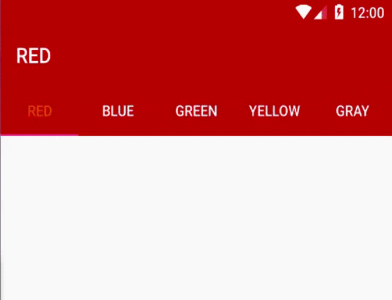By using
TabLayout widget of Design Support Library, we can make this effect easily.Basically, within the
onTabSelected() method of my TabLayout.OnTabSelectedListener implementation, I wanted to animate from the current color to the new tab’s corresponding color, ensuring that all views are animating simultaneously. Call this interface through addOnTabSelectedListener():
tabLayout.addOnTabSelectedListener(new TabLayout.OnTabSelectedListener() {
@Override
public void onTabSelected(TabLayout.Tab tab) {
//Add more code in this method later
}
@Override
public void onTabUnselected(TabLayout.Tab tab) {
}
@Override
public void onTabReselected(TabLayout.Tab tab) {
}
ValueAnimator which allows you to iterate over the difference of two values over a timed interval. I also used an ArgbEvaluator for the ValueAnimator’s evaluator to handle the calculation of each animation step between the two ARGB colors:
int colorFrom = ((ColorDrawable) toolbar.getBackground()).getColor();
int colorTo = getColorForTab(tab.getPosition());
Now the
ValueAnimator can be used to inform us of what color to use during each animation iteration:
colorAnimation.addUpdateListener(new ValueAnimator.AnimatorUpdateListener() {
@Override
public void onAnimationUpdate(ValueAnimator animator) {
int color = (int) animator.getAnimatedValue();
toolbar.setBackgroundColor(color);
tabLayout.setBackgroundColor(color);
if (Build.VERSION.SDK_INT >= Build.VERSION_CODES.LOLLIPOP) {
getWindow().setStatusBarColor(color);
}
}
});
colorAnimation.start();
colorAnimation.start():
colorAnimation.setDuration(1000); //time in milliseconds
MainActivity.java
And that’s all there is to it - we now have a good animation, make our app look more smoothly and prettier! This is full screen output:package info.devexchanges.synchronouslycolor;
import android.animation.ArgbEvaluator;
import android.animation.ValueAnimator;
import android.graphics.drawable.ColorDrawable;
import android.os.Build;
import android.os.Bundle;
import android.support.design.widget.TabLayout;
import android.support.v4.content.ContextCompat;
import android.support.v7.app.AppCompatActivity;
import android.support.v7.widget.Toolbar;
public class MainActivity extends AppCompatActivity {
private TabLayout tabLayout;
private Toolbar toolbar;
private String[] colors = {"Red", "Blue", "Green", "Yellow", "Gray"};
@Override
protected void onCreate(Bundle savedInstanceState) {
super.onCreate(savedInstanceState);
setContentView(R.layout.activity_main);
tabLayout = (TabLayout) findViewById(R.id.tab_layout);
toolbar = (Toolbar) findViewById(R.id.toolbar);
setSupportActionBar(toolbar);
for (String color : colors) {
tabLayout.addTab(tabLayout.newTab().setText(color));
}
tabLayout.setTabGravity(TabLayout.GRAVITY_FILL);
tabLayout.addOnTabSelectedListener(new TabLayout.OnTabSelectedListener() {
@Override
public void onTabSelected(TabLayout.Tab tab) {
int colorFrom = ((ColorDrawable) toolbar.getBackground()).getColor();
int colorTo = getColorForTab(tab.getPosition());
ValueAnimator colorAnimation = ValueAnimator.ofObject(new ArgbEvaluator(), colorFrom, colorTo);
colorAnimation.setDuration(1000);
colorAnimation.addUpdateListener(new ValueAnimator.AnimatorUpdateListener() {
@Override
public void onAnimationUpdate(ValueAnimator animator) {
int color = (int) animator.getAnimatedValue();
toolbar.setBackgroundColor(color);
tabLayout.setBackgroundColor(color);
if (Build.VERSION.SDK_INT >= Build.VERSION_CODES.LOLLIPOP) {
getWindow().setStatusBarColor(color);
}
}
});
colorAnimation.start();
toolbar.setTitle(colors[tab.getPosition()].toUpperCase());
}
@Override
public void onTabUnselected(TabLayout.Tab tab) {
}
@Override
public void onTabReselected(TabLayout.Tab tab) {
}
});
}
public int getColorForTab(int position) {
if (position == 0) return ContextCompat.getColor(this, R.color.colorPrimary);
else if (position == 1) return ContextCompat.getColor(this, R.color.blue);
else if (position == 2) return ContextCompat.getColor(this, R.color.green);
else if (position == 3) return ContextCompat.getColor(this, R.color.yellow);
else return ContextCompat.getColor(this, R.color.gray);
}
}
References:

